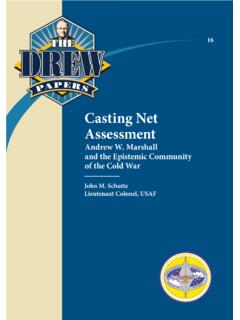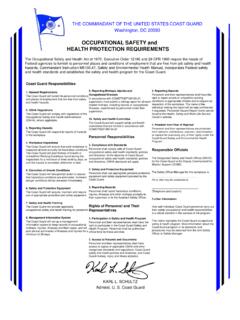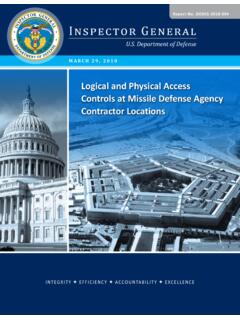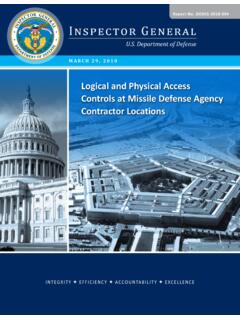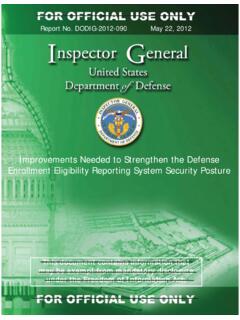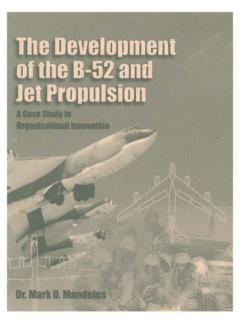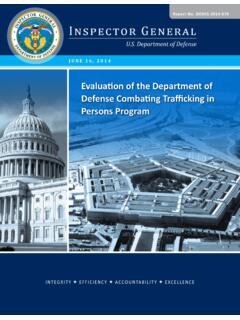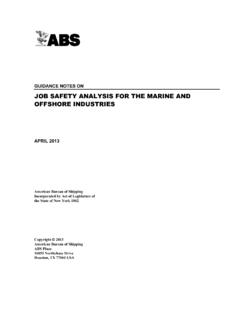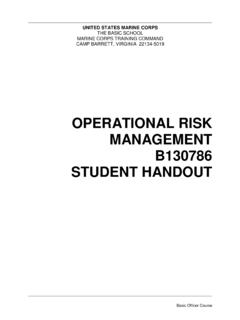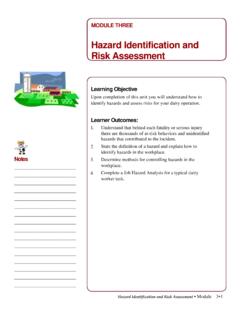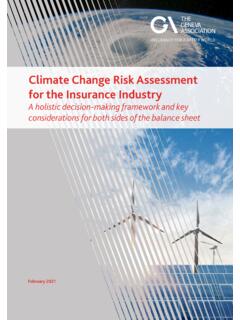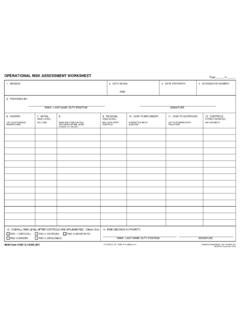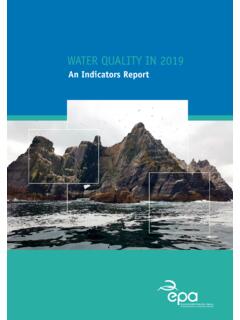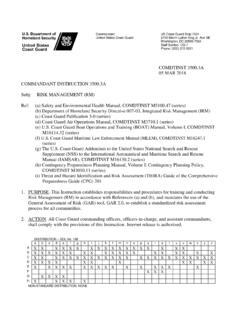Transcription of DOD Climate Risk Analysis - media.defense.gov
1 Department of DefenseClimate Risk AnalysisOctober 2021To the National Security Council2 EXECUTIVE SUMMARYC limate change is reshaping the geostrategic, operational, and tactical environments with significant implications for national security and defense. Increasing temperatures; changing precipitation patterns; and more frequent, intense, and unpredictable extreme weather conditions caused by Climate change are exacerbating existing risks and creating new security challenges for interests. The risks of Climate change to Department of Defense (DoD) strategies, plans, capabilities, missions, and equipment, as well as those of allies and partners, are growing. Global efforts to address Climate change including actions to address the causes as well as the effects will influence DoD strategic interests, relationships, competition, and priorities.
2 To train, fight, and win in this increasingly complex environment, DoD will consider the effects of Climate change at every level of the DoD enterprise. The DoD Climate Risk Analysis (DCRA) responds to requirements specified in Executive Order (EO) 14008, Tackling the Climate Crisis at Home and Abroad. 1 The DCRA is organized as follows: Section I introduces key security implications of Climate change to DoD, including DoD s role supporting whole-of-government and international efforts in concert with allies and partners. Section II reviews DoD Climate policy and responsibilities, highlighting key documents. Section III presents a review of Climate hazards, risks , and security implications. Sections on specific regions have been identified as Controlled Unclassified Information (CUI) and not releasable to the public.
3 These sections were removed to allow this to be a publicly-releasable document. Section IV outlines how DoD will incorporate consideration of Climate into relevant strategy, planning, and processes. Section V describes interagency scientific and intelligence products and experts, which could support future analyses of Climate risk, as well as expected funding for exercises, wargames, analyses, and studies related to Climate change. Section VI concludes the DCRA is an important step towards integration of Climate change considerations at DoD. To understand specific Climate effects on plans, resourcing, operations, and missions, DoD Components will include Climate considerations in relevant risk analyses, leveraging high-quality data, scenarios, and analytical tools tailored to DoD needs. Working within the whole-of-government, and in coordination with allies and partners, DoD will strive to prevent, mitigate, account for, and respond to defense and security risks associated with Climate change.
4 Department of Defense Climate Risk Analysis1 EO 14008, Section 103(c) requires the Secretary of Defense to develop an Analysis of the security implications of Climate change ( Climate Risk Analysis ) that can be incorporated into modeling, simulation, war-gaming, and other analyses. 3 PLEASE CITE THIS DOCUMENT AS: Department of Defense, Office of the Undersecretary for Policy (Strategy, Plans, and Capabilities). 2021. Department of Defense Climate Risk Analysis . Report Submitted to National Security Council. 4 FOREWORDTo keep the nation secure, we must tackle the existential threat of Climate change. The unprecedented scale of wildfires, floods, droughts, typhoons, and other extreme weather events of recent months and years have damaged our installations and bases, constrained force readiness and operations, and contributed to instability around the world.
5 Climate change touches most of what this Department does, and this threat will continue to have worsening implications for national security. To meet this complex challenge, the Department of Defense (DoD) is integrating Climate change considerations at all levels, including in our risk analyses, strategy development, planning, modeling, simulation, and war gaming. The DoD Climate Risk Analysis (DCRA) is a critical step for incorporating Climate change security implications at a strategic level. As the global and cross-cutting consequences of Climate change increase the demands on the Department, the DCRA provides a starting point for a shared understanding of the mission risks of Climate change and lays out a path forward. For example, Climate considerations will be included in key DoD documents, such as the forthcoming National Defense Strategy, which guides the ways that DoD meets national security challenges.
6 Coupled with the Climate Adaptation Plan, which will help the Department operate under changing Climate conditions, the DCRA reflects the Department s focus on confronting Climate change. Climate change presents serious risks , but DoD, along with the entire government, as well as our allies and partners, is determined to address this common threat. The Department will work to prevent, mitigate, and respond to the defense and security risks associated with Climate change. By doing so, we will ensure that we continue to fulfill our mission of defending the United States. Lloyd J. Austin III, Secretary of Defense5I. INTRODUCTION There is little about what the Department does to defend the American people that is not affected by Climate change. Secretary of Defense Austin, Statement Released in January 2021 Climate change is reshaping the geostrategic, operational, and tactical environments with significant implications for national security and defense.
7 Increasing temperatures; changing precipitation patterns; and more frequent, intense, and unpredictable extreme weather conditions caused by Climate change are exacerbating existing risks and creating new challenges for interests. Without adaptation and resilience measures, Climate hazards, particularly when combined with other stressors, are likely to contribute to political, economic, and social instability around the world. In many cases, the physical and social impacts of Climate change transcend political boundaries, increasing the risk that crises cascade beyond any one country or region. Box 1 provides definitions of key terms used in this risks of Climate change to DoD strategies, plans, capabilities, missions, and equipment, as well as those of our allies and partners, are growing. Therefore, analyses based on historical frameworks will not be sufficient to prepare for future risks complicated by a changing Climate .
8 To train, fight, and win in this increasingly complex strategic, operational, and tactical environment, DoD will consider the effects of Climate change at every level of the DoD enterprise. The Department will consider how crises exacerbated by Climate change are likely to increase demand for defense missions and impact critical supply chains, infrastructure, and readiness. Mission success will depend on planning and operational adaptability that account for Climate -related complexities and contingencies, and on forces, equipment, and capabilities engineered to adapt to and withstand more extreme environments. Box 2 includes examples of the security implications of Climate change both at home and 1. DEFINITIONS OF KEY TERMSA daptation - Adjustment in natural or human systems in anticipation of or response to a changing environment in a way that effectively uses beneficial opportunities or reduces negative efforts.
9 (DoD Directive (DoDD) ) Climate Change - Variations in average weather conditions that persist over multiple decades or longer that encompass increases and decreases in temperature, shifts in precipitation, and changing risk of certain types of severe weather events. (DoDD , Joint Publication (JP) 1-02) Climate Change Mitigation - Measures to reduce the amount and speed of future Climate change by reducing emissions of heat-trapping gases or removing carbon dioxide from the atmosphere. ( Global Research Program)Hazard - A condition with the potential to cause injury, illness, or death of personnel; damage to or loss of equipment or property; or mission degradation. (DoD Dictionary, 2021) Resilience - The ability to anticipate, prepare for, and adapt to changing conditions and withstand, respond to, and recover rapidly from disruptions.
10 (DoDD )Risk - Probability and severity of loss linked to threats or hazards and vulnerabilities. (DoDD )6 BOX 2. EXAMPLES OF SECURITY IMPLICATIONS OF Climate CHANGE AT HOME AND ABROAD For the homeland, extreme weather events exacerbated by Climate change have caused hardships for millions of Americans, and have the long-term potential to undermine training capability and readiness. Extreme events have cost the United States billions of dollars in damages in recent years, such as at Tyndall Air Force Base and Marine Corps Base Camp Lejeune. In the Arctic, Climate change is dramatically altering the natural environment and creating a new frontier of geostrategic competition. In the Indo-Pacific, sea-level rise and more extreme weather events complicate the security environment, place key DoD warfighting infrastructure and surrounding communities at risk, and challenge local capacity to respond.
